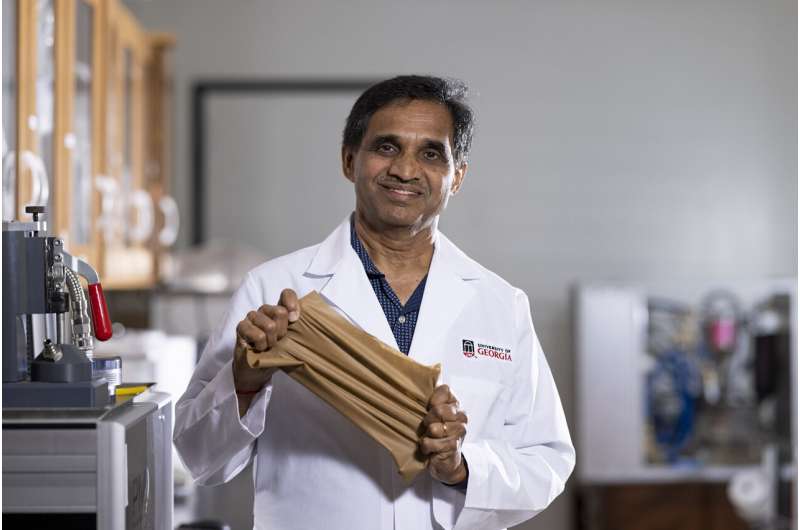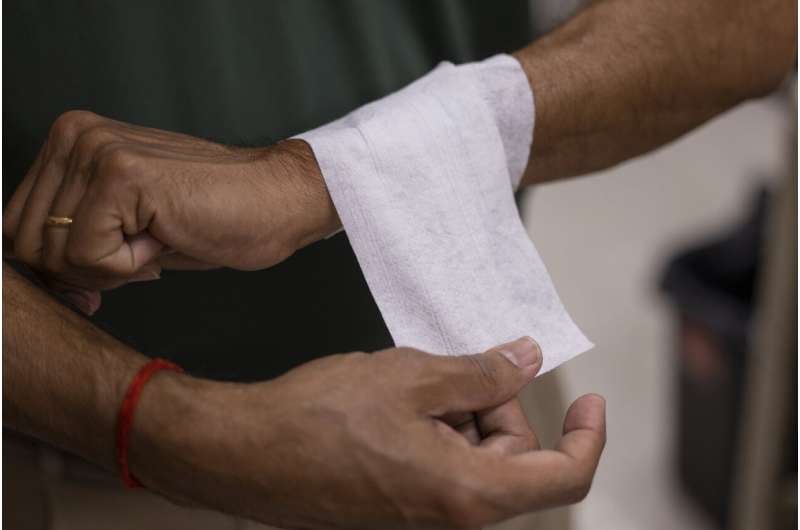New composite material has potential for medical use

University of Georgia researchers have developed a new material with properties ideal for medical products such as masks and bandages. It's also better for the environment than the materials in current use.
Using nonwoven fabrics—fabrics produced by bonding fiber without weaving or knitting—the team led by Gajanan Bhat was able to make composite materials that are stretchable, breathable and absorbent, properties ideal for medical products. Incorporating cotton also makes the resulting material comfortable on the skin (an important factor in medical applications) and easier to compost, hence more sustainable compared to similar products currently in the market.
Funded by the U.S. Department of Agriculture, the researchers tested different combinations of cotton and nonwoven fabrics—for properties such as breathability, water absorbency and stretchability—along with the original nonwoven fabrics. The composite fabrics performed well in the tests, had good air permeability, were more absorbent and had good stretch recovery, meaning they can withstand repeated use.
Demand for nonwoven fabrics has increased in recent years, with the market value expected to reach $77 billion in 2027, according to a report by Acumen Research and Consulting. Nonwoven fabrics are in common household products such as diapers, feminine hygiene products and air and water filters. They are water-resistant, elastic and breathable, and their ability to filter air makes them ideal for medical uses.
"Some of these products for biomedical applications, like Band-Aids and wraps, require some stretch and stretch recovery. But since these come in contact with the body, having cotton will be really helpful," said Bhat, head of the Department of Textiles, Merchandising and Interiors in the College of Family and Consumer Services, who co-authored the paper with master's student and first author Partha Sikdar and Ph.D. student Shafiqul Islam.
While cotton is not as stretchy as nonwovens, it is more water absorbent and softer, making it more comfortable to wear. Cotton is also a major crop in Georgia and an important part of the state's economy. The USDA has been looking for new applications for cotton, and Bhat proposed that they "marry the stretchable nonwoven fabric with cotton and make something cotton-rich and stretchable."

Bhat, who specializes in nonwoven fabrics, thought the resulting material might retain the desirable properties of nonwoven fabrics while also being more comfortable and compostable when disposed.
To test the performance of composite materials, Bhat, Sikdar and Islam combined cotton with two types of nonwoven fabrics, spunbond and meltblown. Spunbond nonwovens contain coarser fiber and are generally stretchier, while meltblown nonwovens contain finer fibers, which allows for better filtration ability.
"The idea is: What combination gives us good performance?" Bhat said. "You want it to be stretchable with some stretch recovery, but at the same time breathable and with some absorbency."
The team prepared nonwoven fabrics of different thicknesses and combined them with either one sheet or two sheets of cotton fabric, ending up with 13 varieties for testing.
The tests showed that the composite fabrics had improved water absorbency compared to the original nonwovens, while still maintaining good breathability. The water absorption of the composites was three to 10 times higher compared to the fabric without cotton. The composite materials also maintained the ability of nonwovens to recover from being stretched, allowing them to accommodate spontaneous movements without losing their shape.
The process of making composite nonwovens enables the use of lower-quality cotton and sometimes even waste or recycled cotton from production of things like T-shirts and bed sheets, said Bhat, Georgia Athletic Association Professor of Fibers and Textiles. The resulting products are therefore more sustainable and cheaper to produce.
The study was published in the Journal of Industrial Textiles.
More information: Partha Sikdar et al, Microstructure and physical properties of composite nonwovens produced by incorporating cotton fibers in elastic spunbond and meltblown webs for medical textiles, Journal of Industrial Textiles (2021). DOI: 10.1177/15280837211004287
Provided by University of Georgia



















